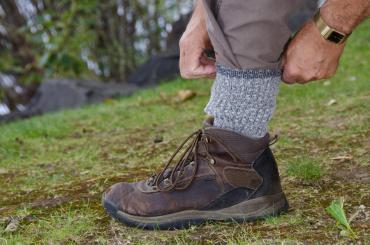Ticks are now active
Daily ticks check recommended after being outdoors
Spring is the beginning of peak tick season, and in the past few years, numbers of deer ticks in our area have increased significantly. A bite from an infected deer tick can transmit Lyme disease and other diseases, which are becoming more common.
“Since we are all following the statewide Safer at Home order many people have been getting outside with household members to walk, hike, and do yard work while safely staying 6 feet from others. This is beneficial to our physical and mental well-being, but it is important to take the extra safety step of preventing tick bites and checking for ticks after being outdoors,”” says Amanda Kita-Yarbro, Communicable Disease Epidemiologist for Public Health Madison & Dane County. Preventing tick bites is the best defense from getting a tick-borne disease.
- Avoid wooded and brushy areas with high grass, and walk in the center of trails when hiking.
- Due to the increase in ticks in our area, make tick checks part of a daily routine, even if you’ve only been in urban parks or backyards.
- Use repellents containing 20-30% DEET on both exposed skin and clothing, carefully following product instructions. CDC’s website also lists natural tick repellents and pesticides.
- Use products that contain permethrin on clothing, carefully following product instructions.
- Do a full-body tick check using a mirror and shower or bathe as soon as possible after coming indoors.
- Tumble clothing you’ve worn on high heat in a dryer, to kill any ticks on clothing.
A tick bite usually results in a rash resembling a bullseye, but not everyone gets that kind of rash, and sometimes don’t even see a tick on their body. “If you’re experiencing fever, rash, chills, headache, fatigue, muscle and joint aches, or swollen lymph nodes and have been spending time outdoors, it’s best to talk to your healthcare provider, even if you haven’t seen a tick on your body or a bullseye rash,” says Kita-Yarbro.
These early symptoms of Lyme disease and other tick-borne diseases like anaplasmosis can occur anywhere from three to 30 days after a bite from an infected tick. When treated with antibiotics in the early stages of symptoms, recovery is usually rapid and complete.
Public Health Madison & Dane County has seen an average of 140 Lyme disease cases per year over the last three years, and additionally sees about 10-15 cases of anaplasmosis each year.
For Lyme disease that is left untreated, infection can spread to joints, the heart and the nervous system. Anaplasmosis, even in healthy people, can be serious and sometimes fatal if the correct treatment is not chosen.
In addition to watching for bullseye rashes, people can look for round or oval rashes that gradually expand, reaching up to 12 inches or more.
Remember that ticks can be as small as a poppy seed or sesame seed. It’s important that ticks be removed completely, and as soon as possible.
Dogs are also very susceptible to tick bites and the diseases they cause. Prevention is the best defense for them as well. Tick preventive products should be used on dogs regularly and tick checks should be done daily. If a tick comes into the house on a dog, it could bite another pet or person living in the house.
Contacts
- Media Inquiries, (608) 243-0482, communications@publichealthmdc.com
